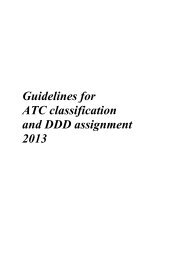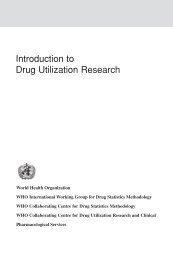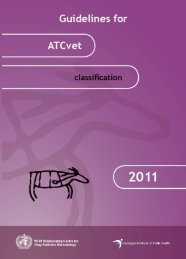Guidelines for ATC classification and DDD assignment - WHOCC
Guidelines for ATC classification and DDD assignment - WHOCC
Guidelines for ATC classification and DDD assignment - WHOCC
You also want an ePaper? Increase the reach of your titles
YUMPU automatically turns print PDFs into web optimized ePapers that Google loves.
Prescribed daily dose<br />
The prescribed daily dose (PDD) can be determined from prescription studies,<br />
medical- or pharmacy records <strong>and</strong> patient interviews. It is important to relate the<br />
PDD to the diagnosis on which the dosage is based. The PDD will give the average<br />
daily amount of a drug that is actually prescribed. When there is a substantial<br />
discrepancy between the PDD <strong>and</strong> the defined daily dose (<strong>DDD</strong>), it is important to<br />
take this into consideration when evaluating <strong>and</strong> interpreting drug consumption<br />
figures.<br />
For drugs where the recommended dosage differs from one indication to another<br />
(e.g. the antipsychotics) it is important that diagnosis is linked to the prescribed<br />
daily dose given. Pharmacoepidemiological in<strong>for</strong>mation (e.g. sex, age <strong>and</strong><br />
mono/combined therapy) is also important in order to interpret a PDD.<br />
The PDD can vary according to both the illness treated <strong>and</strong> national therapy<br />
traditions. For the antiinfectives, <strong>for</strong> instance, PDDs vary according to the severity<br />
of the infection. There are also substantial differences between PDDs in various<br />
countries, which can be up to a four to five fold range. PDDs in Asian populations<br />
are often lower than in Caucasian populations.<br />
The fact that PDDs may differ from one country to another should always be<br />
considered when making international comparisons.<br />
It should be noted that the prescribed daily dose does not necessarily reflect actual<br />
dose consumed.<br />
IV. USE AND MISUSE OF THE <strong>ATC</strong>/<strong>DDD</strong> SYSTEM<br />
The main purpose of the <strong>ATC</strong>/<strong>DDD</strong> system is as a tool <strong>for</strong> presenting drug<br />
utilization statistics with the aim of improving drug use. This is the purpose <strong>for</strong><br />
which the system was developed <strong>and</strong> it is with this purpose in mind that all<br />
decisions about <strong>ATC</strong>/<strong>DDD</strong> <strong>classification</strong> are made. Consequently, using the<br />
system <strong>for</strong> other purposes can be inappropriate. The system has been used since the<br />
early 1970s in drug utilization studies where it has been demonstrated to be suitable<br />
<strong>for</strong> national <strong>and</strong> international comparisons of drug utilization, <strong>for</strong> the evaluation of<br />
long term trends in drug use, <strong>for</strong> assessing the impact of certain events on drug use<br />
<strong>and</strong> <strong>for</strong> providing denominator data in investigations of drug safety (see also point<br />
I C The purpose of the <strong>ATC</strong>/<strong>DDD</strong> system, page 14).<br />
National implementation of the <strong>ATC</strong>/<strong>DDD</strong> methodology<br />
For monitoring <strong>and</strong> comparing drug use internationally it is important to ensure that<br />
the data retrieved are comparable. In order to facilitate data collection it is<br />
recommended to establish national medicinal product registries. It is recommended<br />
to have a common structure of these registries. The <strong>ATC</strong> code <strong>and</strong> <strong>DDD</strong> should be<br />
31





